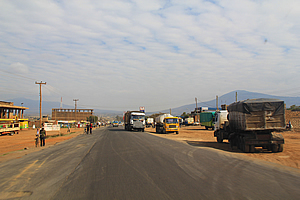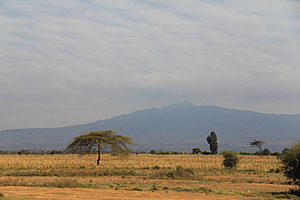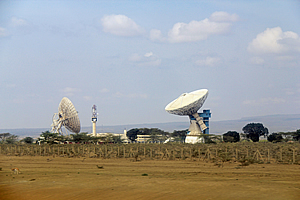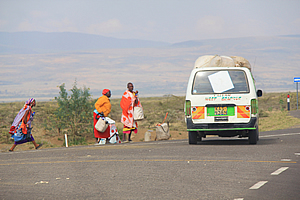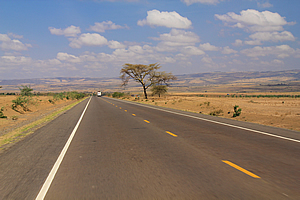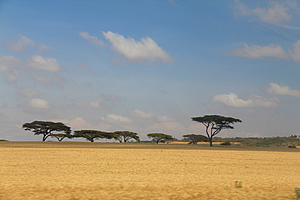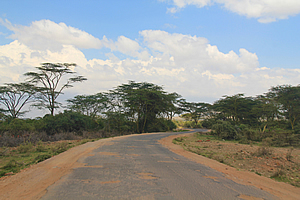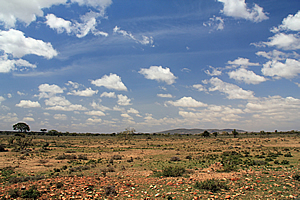--- Archive files ---
Home > Travels > Masai Mara > 2 |
The Mara Road
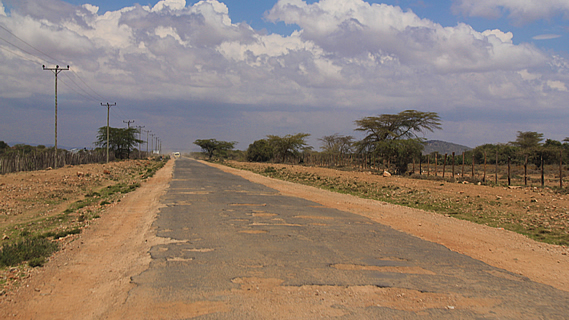
UPON reaching the bottom of the Rift Valley and drove through a small town with a very wide main street before starting to cross the valley. The main road had a row of crooked power lines running along one side, and there were numerous small shops and a couple of churches along the side of the road. Most buildings were one or two storeys, apart from one five storey block that was currently under construction.
Town in the Rift Valley |
The prairie beyond the small town was quite barren, with numerous scrubby acacia or candlestick trees dotted all over the place. There was a lot of livestock being walked along the side of the road by Masai farmers who live there. The livestock were mostly skinny cows or goats. No doubt they were in search for food as this was the middle of the dry season and everything appeared very dry here. The road was in good condition aside from a number of filled in potholes.
The dust haze quickly obscured the hill we had come down into a grey not much darker than the haze above it. This was how I would imagine Valles Marineris on Mars to be. The nine kilometre high magnificent cliffs would become obscured by dust as you cross the valley floor hundreds of kilometres wide. Even if it was perfectly clear, one side of the wall would disappear below the horizon before you reach the other side thanks to the increased curvature of the smaller planet of Mars.
The Rift Valley |
The plain was a lot hillier than I had imagined. Large hills dotted the landscape indicating small eruptions where lava had filled in cracks formed from the tectonic plates on either side of us separating. Occasionally we would pass a sign to a hot spring, evidence of water seeping through cracks in the rock towards the magma only a few kilometres below us. This reminded me that the earth’s crust here was very thin and weak compared to most other parts of the world. We did soon reach the other side of the valley, and the ridge on this side was not as pronounced as on the other side. Rather than climbing a substantial hill, there were numerous hills to go over where deep valleys had been cut into this side. The hills were rather large and dome-shaped indicating a relatively low rainfall here.
Satellite dishes |
In the middle of the rift valley was a sophisticated looking communications station with two huge radio telescopes, no doubt pointing to satellites unseen high above the sky. Occasionally we would cross a small river with vertical cliffs carved deep into the ground, as if following the cracks of the plates tearing apart. Ahead of us was a matatu van picking up a family. They offered public transport even out here to my surprise.
The land here was a lot drier than it had been at the bottom of the side of the valley. It was very arid yet there were people herding their livestock no doubt finding better grazing pastures. A couple of large dust devils appeared in the distance. The rising air created a vortex pulling the dust of the surface of the earth high up into the haze.
A matatu picking up locals |
Joseph then told me there were some giraffes out my window. I had a look and after a while I finally saw them way off in the distance eating some of the foliage of the trees. Joseph must have amazing eyesight for spotting things. He had by now mentioned that he has descended from the Masai. He was definitely out of shape, but he still had their acute vision.
Shortly afterwards we reached another small town, about half the size of the one we had passed earlier. Joseph said we were now in Masai territory – actually we had been in Masai territory since reaching the valley. He said Masai people didn’t like being photographed because they believe it takes their spirits away. He did say though that the ones we will be meeting later today and over the next few days will be happy for us to photograph them as they understand that's just a part of how the tourism industry works.
Road across the Rift Valley |
The road continued across the plain, but shortly I could clearly see the other side of the rift valley. The hills on the other side were a lot lower than the ones we had come down, but I think we were actually heading towards an island in the rift valley rather than the end itself. Here the land didn’t see quite so parched, with the occasional cornfield and the old small village. Here the acacia trees were very flat with wide tops.
Then the terrain changed. Rather than being on flat plain any more we were now travelling over long hills going from ridge to valley. Perhaps this was due to a compound faulting occurring here.
The Rift Valley |
We went over hill after hill until eventually reaching a town. We stopped at the last petrol station before Masai Mara. Following Joseph’s advice, I bought all the drinking water I needed for the trip. Water past here was quite expensive.
The tiny shop was packed full of other tourists who had piled out of all the other tourist vans, jeeps and trucks parked here. Therefore it took me quite a long time to get to the counter. It was two hundred shillings (about two dollars) for two one litre bottles of water.
Masai Road - many potholes! |
We left the petrol station, then Joseph warned me that I was about to get a free massage. Shortly after leaving the town, we turned off the main road to follow a narrow side sealed road that goes to Masai Mara. Almost immediately the potholes began. Now I quickly understood what he meant by getting a free massage today. I wouldn’t exactly call this a massage recalling the massages I had received in South East Asia in past trips, it was very jarring and I was glad my back was in good condition – I had hurt it a few weeks ago but fortunately it had by now healed. Hopefully it won’t go bad again. Anyone with a bad back would have found this road to be absolute torture.
Masai Plain |
The road was straight and the land reasonably flat, so we should have been able to make at least one hundred kilometres per hour if the road was in good condition. We were still going over the ridges and valleys but the rise and fall wasn’t very noticeable at all. There was a small village at the top of a rise, then after that the road got really bad. A row of wooden power poles followed the road on the left hand side.
The potholes here were so bad that in many places there was actually more pothole in the road than there was seal. We were therefore slowed to a jarring crawl of twenty five kilometres per hour. There were some areas where men were shovelling sand into the potholes to make the road a bit smoother, but otherwise it was completely unmaintained. We passed five broken down tour vehicles that had been damaged from the vibrations of driving along the road. No wonder there had been a disclaimer on the tour that I had booked that they couldn’t guarantee the vehicles would get us to where we wanted to go.
<< Previous | Next >> |
|
||
About this Page
|
||
|
|
|
Where is Walkabout Jeff? |
|
|
|
|
What is happening in Walkabout Jeff's hometown?
|
|
|
|
|
Who is Walkabout Jeff?Any normal person's idea of going out involves going to the local pub for a drink with a few mates. Walkabout Jeff isn't normal.
|
|
|
|
|
